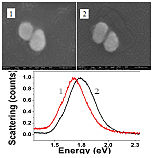We are applying spectroscopic techniques to solve problems in nanoscience. One of our main focus areas is the study of localized plasmons of metallic and metal-based nanoparticles and nanostructures. The optical properties of these structures are quite fascinating, and include a strong effect of geometry on the optical resonant properties, size dependent effects controlling light absorption and scattering, and plasmon-plasmon interactions, as observed in reduced symmetry nanoparticles and finite nanoparticle aggregates. These latter systems are of particular interest, giving rise to a rich variety of coupled-oscillator behavior such as Fano resonances, electromagnetically induced transparency (EIT), sub- and superradiance, and many other interesting phenomena. Although these phenomena are of fundamental interest yet they have the potential to impact applied areas e.g., solar-energy conversion, advanced imaging techniques, forensic science, etc.
The excitation of a nanoparticle surface plasmon gives rise to absorption and scattering, and also creates a strong local electromagnetic field around the metal nanoparticle surface. Ensemble extinction spectroscopy measures the sum of both absorption and scattering and averages over all nanoparticle sizes and shapes present within the detection volume. To eliminate inhomogeneous broadening of the surface plasmon resonance due to distributions in particle size, shape, and environment, as our main tool, we are using single-particle spectroscopy and imaging techniques to understand the radiative and nonradiative properties of individual plasmonic nanoparticles and their finite assemblies. Single particle spectroscopy, especially when correlated with structural imaging using electron microscopy, provides the ultimate resolution and has enabled major breakthroughs in materials chemistry and physics because heterogeneous distributions of nanoparticle shape, size, and orientation or interfacial nanoscale structure can be measured directly.The goal is to determine the plasmonic properties of anisotropic nano- structures that are used as sensors or biological probes and for comparison to more complex nanoparticle assemblies.

-
Optimization of nonlinear optical localization using electromagnetic surface fields (NOLES) imaging,J. Chem. Phys., 138, 214202 (2013)
-
Probing the Structure-Property Interplay of Plasmonic Nanoparticle Transducers using FemtosecondLaser Spectroscopy,J. Phys. Chem. Lett., 4, 1109 (2013).
-
Nanoparticle surface electromagnetic fields studied by single particle nonlinear optical spectroscopy,Phys. Chem. Chem. Phys., 15, 4177 (2013).
-
Magnetic Dipolar Interactions in Solid Gold Nanosphere Dimers,J. Am. Chem. Soc., 134, 4477 (2012).
-
Three-Dimensional Interfacial Structure Determination of Hollow Gold Nanosphere Aggregates,J. Phys. Chem. Lett., 2, 2946 (2011).
-
Two-Photon Rayleigh Scattering from Isolated and Aggregated Hollow Gold Nanospheres,J. Phys. Chem. C, 114, 19971 (2010).
-
Controlled Plasmon Resonance Properties of Hollow Gold Nanosphere Aggregates,,J. Am. Chem. Soc., 132, 15782 (2010).
-
Small-particle limit in the Second Harmonic Generation from Noble Metal Nanoparticles, Chem. Phys.,358, 203 (2009)
-
Postdoctoral Fellow, Florida State University and National High Magnetic Field Laboratory, 2009-2013
-
Assistant Professor, IIT Kanpur, 2013-2018
-
Associate Professor, IIT Kanpur, 2018
Office
FB-424,
Department of Chemistry
IIT Kanpur,
Kanpur 208016
Office Phone: 0512-259-7265 (O)
Email: mchandra[AT]iitk.ac.in
|
|
|












